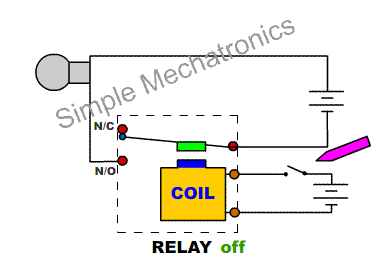RELAYS
Relays are used to control high voltage and/or high current equipment/gadget using a switch, which consumes low and safe voltage and/or current. In other words, relay is a mediator to convert low and safe operating power to high operating power requirement.

A relay is also used to isolate the high voltage power supply from low voltage control power supply, thus protecting the operator from high voltage operating risk.
Some times Relays are used to control AC equipment with DC signal and vice-versa. One of the main advantage of a relay is the isolation of control power supply (AC/DC) with the main operating power supply (AC/DC). i.e., independent of AC and DC power supplies.
Relay Construction:
A relay consists of an electro-magnet and a set of strips (conductors) connected parallel on to a steel plate with isolation to each other. Each strip is fixed at one end, which is called as common pin and other end is set free, which works as a lever.
One contact on electro-magnet side or two contacts on both sides of the free end is provided with a fixed gap. The free end is set away from the electro-magnet pointing towards the steel plate, by default. The free end of the strip(s) moves towards the magnet by attracting steel plate, when the coil of electro-magnet is energised by a power supply.
The contact away from the electro-magnet, normally connecting to free end of the strip is called Normally Closed (N/C) contact. The contact towards the electro-magnet, normally disconnected to the free end of the strip is called Normally Open (N/O) contact. The N/O contact gets connected to the free end of the strip when the electro-magnet is enegised and attracts the steel plate towards it.


The working principle of a SPDT Relay is shown in animation here for easy understanding.
Relay Types:
If only one contact is available to touch the free end of the strip, then it is called Single Throw (ST) contact. If two contacts are available to touch on both sides of free end of the strip, then it is called Double Throw (DT) contact.
If one strip is connected to the steel plate then it is called Single Pole (SP). In case, two strips are connected to the steel plate then it is called as Double Pole (DP). Similarly, if three strips are connected to the steel plate, then it is called as Triple Pole (TP).



The number of poles (strips) and number of throws combination available in relays are:
-
SPST = Single Pole Single Throw
-
DPST = Double Pole Single Throw
-
TPST = Triple Pole Single Throw
-
SPDT = Single Pole Double Throw
-
DPDT = Double Pole Double Throw
-
TPDT = Triple Pole Double Throw
The electrical characteristics of a relay to be observed, which are normally printed on the cover / encloser of the relay :
-
Operating voltage of the electro-magnet coil : One of the most important specification of the relay is the operating voltage of eletro-magnet coil and also check the AC/DC which energises the coil. Voltage applied above the rated value may damage the coil and less voltage may not have sufficient magnetic power to pull the steel plate to switch on the relay.
-
Operating Voltage and Current of the poles : The Maximum Voltage and Current handling capacity of the poles (strips) are also important to the match the requirement. The values may vary for AC circuit and DC circuit. So, care should be taken while selecting proper relay.
-
Number of poles : The number of contacts (strips) get connected and disconnected while operating the relay should match the requirement.
-
Number of Throws : A double throw relay may be used in place of single throw relay, but, reverse may not serve the purpose, if both the poles are used in the circuit.
-
Size, Shape and connecting details : If, the relay is to be replaced in an existing circuit, then it has to suit the connector. Some times, size and shape are also important to accommodate in the circuit board.